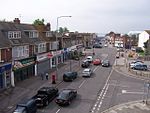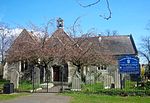HMS Europa (shore establishment)
HMS Europa was a Royal Navy Shore establishment active between 1939 and 1946 during World War II as the central depot for the Royal Naval Patrol Service (RNPS). It was established after the commandeering of Sparrows Nest Gardens, a private residence in Lowestoft in Suffolk. Originally named Pembroke X, the base was the headquarters of the RNPS, responsible for protecting coastal Britain and its convoys, in particular undertaking minesweeping duties. Over 70,000 men and 6,000 vessels, many of them small civilian vessels such as armed trawlers, served in the RNPS during the war.The base was decommissioned in 1946. It is now the site of Lowestoft War Memorial Museum.
Excerpt from the Wikipedia article HMS Europa (shore establishment) (License: CC BY-SA 3.0, Authors).HMS Europa (shore establishment)
Church Road, Southampton Woolston
Geographical coordinates (GPS) Address Nearby Places Show on map
Geographical coordinates (GPS)
| Latitude | Longitude |
|---|---|
| N 50.893 ° | E -1.378 ° |
Address
Church Road 82
SO19 9FS Southampton, Woolston
England, United Kingdom
Open on Google Maps








